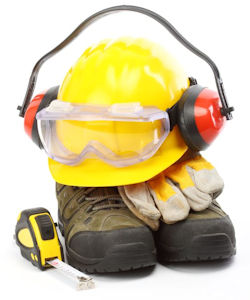Types of Protective Equipment
The Requirement for PPE
To ensure the greatest possible protection for employees in the workplace, the cooperative efforts of both employers and employees will help in establishing and maintaining a safe and healthful work environment.

In general, employers are primarily responsible for the following actions under the PPE program:
- Performing a "hazard assessment" of the workplace to identify and control physical and health hazards.
- Identifying and providing appropriate PPE for employees.
- Training employees in the use and care of the PPE.
- Maintaining PPE, including replacing worn or damaged PPE.
- Periodically reviewing, updating and evaluating the effectiveness of the PPE program.
In general, employees should:
- Properly wear PPE,
- Attend training sessions on PPE,
- Care for, clean and maintain PPE, and
- Inform a supervisor of the need to repair or replace PPE
Specific requirements for PPE are presented in many different OSHA standards, published in 29 CFR. Some standards require that employers provide PPE at no cost to the employee while others simply state that the employer must provide PPE. OSHA Publication 3151, Personal Protective Equipment, Appendix A contains OSHA standards that require PPE.
In December 2024, a construction company was fined more than $130,000 by Oregon OSHA for repeatedly exposing employees to fall hazards. During an inspection at a residential jobsite, inspectors observed an employee installing roofing material without proper fall protection. Although the worker wore a harness, it was not connected to an anchor, exposing them to a potential fall of up to 17 feet. Additionally, an extension ladder used on-site did not extend at least 3 feet above the roofline, and employees operated pneumatic nail guns without eye protection.
Luckily, no injuries or fatalities were reported in this incident. However, the company faced penalties for repeated fall protection, ladder safety and eye protection violations.
To prevent such hazards and penalties, companies should:
- Enforce Fall Protection Measures: Ensure all employees working at heights use properly connected fall protection equipment.
- Adhere to Ladder Safety Standards: Verify that ladders extend appropriately above landing surfaces to provide safe access.
- Implement Personal Protective Equipment (PPE) Policies: Mandate the use of necessary PPE, such as eye protection, when operating hazardous tools.
Regular training and strict adherence to safety protocols are essential to maintaining a safe work environment and complying with OSHA regulations.
Knowledge Check Choose the best answer for the question.
1-1. Which of the following is a primary employer responsibility under the company's PPE program?
You forgot to answer the question!
